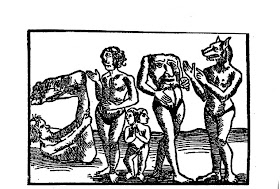Here are some of the 'people' who were thought to exist:
- Sciopods - people with one leg and a foot so big they used it for shade
- Cyclopes - people with one, central eye
- Pygmies - short people (though I'm not sure why this one has two heads)
- Blymmyes - people with faces on their chest
- Cynocephalus - dog-headed people

(Large eared people - I didn't come across a name - image from Wikipedia)

(Sciapod/Skiapod/Monopod - from the Nuremburg Chronicle 1493 - image from Wikipedia)
Pliny describes Skiapods as follows: He [Ctesias] speaks also of another race of men, who are known as Monocoli, who have only one leg, but are able to leap with surprising agility. The same people are also called Sciapodae, because they are in the habit of lying on their backs, during the time of the extreme heat, and protect themselves from the sun by the shade of their feet. (Ctesias' book was about India from the 5th century B.C.)
In this age of mass information and Google Earth it is hard to believe that people believed these human 'monstrosities' really existed. But, even today, we talk about leprechauns and big foot! Anyway, I can't wait to visit Europe and examine some of this medieval art in person.
P.S. I really enjoyed a related post called "How Columbus Discovered Cannibals in the New World" which talks about the dog-headed people and how Columbus used this idea to justify enslaving people.

No comments:
Post a Comment